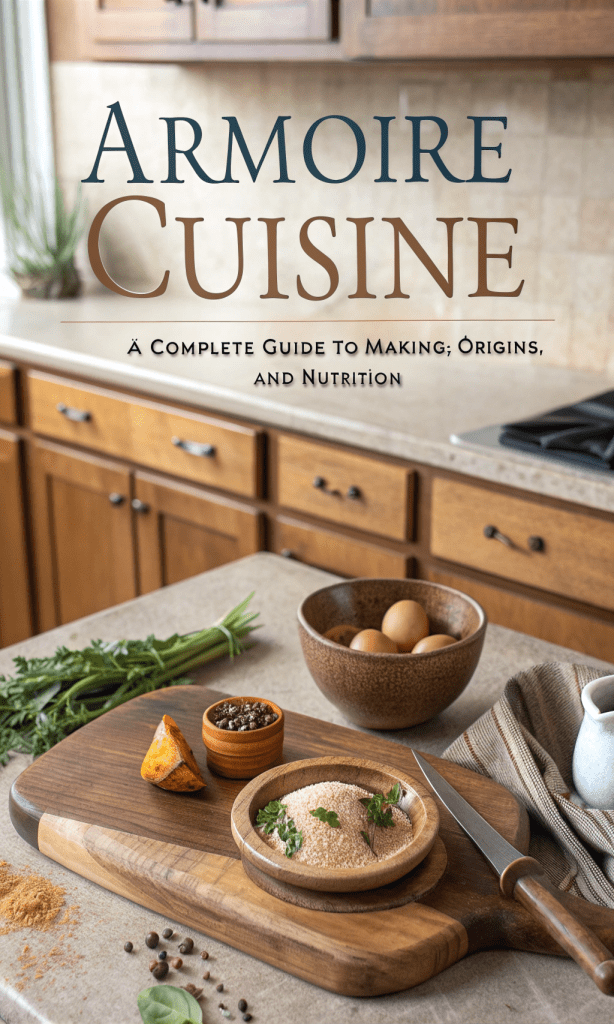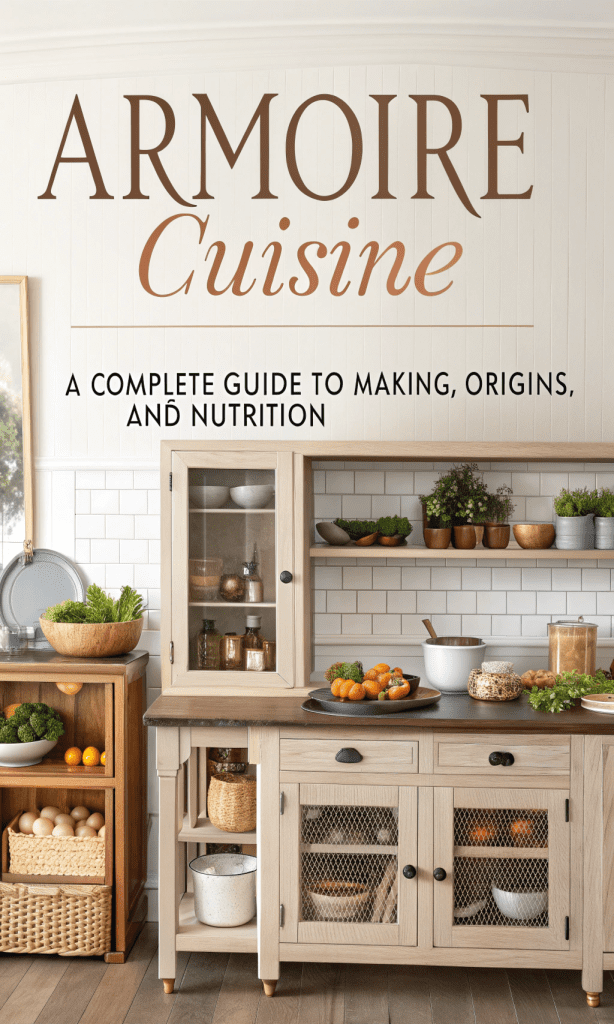
Armoire cuisine, a term that evokes the rustic charm of French culinary tradition, refers to a versatile and flavorful dish rooted in the heart of French home cooking. This comprehensive guide explores how to make armoire cuisine, its historical origins, nutritional values, and essential information to help you master this delightful dish. Whether you’re a seasoned chef or a curious beginner, this article provides everything you need to bring the essence of armoire cuisine to your kitchen.
What Is Armoire Cuisine?
Armoire cuisine, loosely translated as “kitchen cupboard” cuisine, embodies the French philosophy of creating delicious meals using pantry staples. It’s not a single recipe but a style of cooking that emphasizes resourcefulness, combining simple ingredients like grains, legumes, vegetables, and preserved meats or fish to craft hearty, flavorful dishes. Think of it as the art of turning everyday items into culinary masterpieces, much like the French cassoulet or ratatouille but with a focus on what’s readily available in your pantry.
This approach originated in rural French households, where families relied on preserved foods and seasonal produce to create nourishing meals. Today, armoire cuisine inspires home cooks worldwide to embrace creativity and sustainability by using what’s on hand.
The Origins of Armoire Cuisine
Historical Roots in French Culture
Armoire cuisine traces its roots to rural France, particularly in regions like Provence, Brittany, and Normandy, where resourcefulness defined cooking. In the 18th and 19th centuries, French peasants and farmers developed this style to make the most of limited resources. Pantries, or “armoires,” stored essentials like dried beans, lentils, root vegetables, cured meats, and preserved fish. These ingredients formed the backbone of meals that sustained families through long winters or lean times.
The concept aligns with the French principle of cuisine du terroir, which celebrates local, seasonal ingredients. Unlike the elaborate dishes of French haute cuisine, armoire cuisine reflects the ingenuity of home cooks who transformed humble staples into comforting, flavorful meals. Over time, this approach spread beyond France, influencing global cuisines that value pantry-based cooking, such as Italian cucina povera or Spanish peasant stews.
Evolution into Modern Kitchens
Today, armoire cuisine has evolved into a modern culinary trend, appealing to those who value sustainability and minimal waste. Chefs and home cooks alike embrace its flexibility, using whatever ingredients are available to create dishes that are both economical and delicious. The rise of meal-prep culture and the focus on reducing food waste have further popularized this approach, making it a staple in contemporary kitchens.
How to Make Armoire Cuisine: A Step-by-Step Guide
Creating armoire cuisine is about embracing simplicity and creativity. Below is a step-by-step guide to crafting a classic armoire cuisine dish, inspired by a traditional French pantry stew. This recipe serves as a template, allowing you to adapt based on your available ingredients.
Ingredients for a Classic Armoire Cuisine Stew (Serves 4-6)
- 1 cup dried white beans (e.g., cannellini or navy beans), soaked overnight
- 2 tablespoons olive oil
- 1 large onion, diced
- 2 garlic cloves, minced
- 2 carrots, sliced
- 2 celery stalks, chopped
- 1 cup canned tomatoes, diced
- 4 cups vegetable or chicken broth
- 1 bay leaf
- 1 teaspoon dried thyme
- 1 teaspoon smoked paprika (optional for depth)
- 200 grams preserved meat (e.g., sausage, bacon, or ham), diced (optional for vegetarians)
- 1 cup kale or spinach, chopped
- Salt and pepper to taste
- Crusty bread, for serving
Step-by-Step Instructions
- Prepare the Beans: Rinse the soaked beans and drain. Place them in a large pot, cover with water, and simmer for 45-60 minutes until tender. Drain and set aside. (Alternatively, use canned beans for quicker prep.)
- Sauté the Aromatics: Heat olive oil in a large pot over medium heat. Add diced onion and cook for 3-4 minutes until translucent. Stir in garlic, carrots, and celery, cooking for another 5 minutes until softened.
- Add Tomatoes and Spices: Stir in canned tomatoes, bay leaf, thyme, and smoked paprika. Cook for 2-3 minutes to let the flavors meld.
- Simmer the Stew: Add the cooked beans and broth to the pot. Bring to a boil, then reduce to a simmer. If using preserved meat, add it now. Let the stew simmer for 20-25 minutes, stirring occasionally, until the flavors deepen.
- Incorporate Greens: Add kale or spinach in the last 5 minutes of cooking. Stir until wilted. Season with salt and pepper to taste.
- Serve and Enjoy: Remove the bay leaf and ladle the stew into bowls. Serve with crusty bread to soak up the rich broth.

Tips for Customization
- Vegetarian/Vegan Option: Skip the meat and use vegetable broth for a plant-based version. Add mushrooms for umami flavor.
- Pantry Swaps: Replace white beans with lentils, chickpeas, or black beans. Use whatever vegetables or herbs you have on hand.
- Flavor Boosters: Experiment with spices like cumin, rosemary, or chili flakes to suit your taste.
This recipe captures the essence of armoire cuisine: simple, adaptable, and deeply satisfying.
Nutritional Values of Armoire Cuisine
The nutritional profile of armoire cuisine varies depending on the ingredients used, but its reliance on whole foods like beans, vegetables, and grains makes it a nutrient-dense choice. Below is an approximate nutritional breakdown for the stew recipe above, based on a single serving (1/6 of the recipe, without meat):
- Calories: 200-250 kcal
- Protein: 10-12 grams
- Fat: 6-8 grams (primarily from olive oil)
- Carbohydrates: 30-35 grams
- Fiber: 8-10 grams
- Sugars: 5-7 grams (from vegetables and tomatoes)
- Sodium: 400-600 mg (varies with broth and seasoning)
- Key Nutrients: High in dietary fiber, vitamin A, vitamin C, iron, and potassium
Calculating Nutritional Values
To calculate precise nutritional values for your armoire cuisine dish, follow these steps:
- List Ingredients and Quantities: Note the exact weight or volume of each ingredient.
- Source Nutrient Data: Use reliable databases like the USDA FoodData Central or nutrition software (e.g., Nutritics or FoodWorks) to find nutrient values for each ingredient.
- Account for Cooking Methods: Consider nutrient losses or gains during cooking (e.g., boiling may reduce water-soluble vitamins like vitamin C).
- Sum the Nutrients: Calculate the total nutrients for the recipe and divide by the number of servings.
For small-scale producers or home cooks without access to lab testing, online nutrition calculators can provide estimates, though they may not account for unique ingredients. For commercial products, consult local regulations to ensure compliance with labeling laws.
Health Benefits
Armoire cuisine’s emphasis on whole, unprocessed ingredients offers several health benefits:
- High in Fiber: Beans and vegetables promote digestive health and help regulate blood sugar.
- Rich in Antioxidants: Ingredients like tomatoes and greens provide vitamins A and C, which support immune function and reduce inflammation.
- Low in Saturated Fat: Plant-based versions are naturally low in unhealthy fats, reducing the risk of heart disease.
- Balanced Macronutrients: The combination of protein, carbs, and healthy fats keeps you full and energized.
For those targeting specific dietary needs, armoire cuisine is easily adaptable. For example, reducing sodium or using low-sugar ingredients can cater to heart-healthy or diabetic diets.
Essential Information About Armoire Cuisine
Why Choose Armoire Cuisine?
Armoire cuisine stands out for its versatility and sustainability. It encourages cooks to:
- Reduce Food Waste: Use leftovers or pantry staples to create new meals.
- Save Money: Rely on affordable ingredients like beans and grains.
- Embrace Creativity: Experiment with flavors and textures without rigid recipes.
- Support Health: Prioritize nutrient-dense, whole foods.
Cultural Significance
Beyond its practical benefits, armoire cuisine carries cultural weight. It reflects the French value of savoir-faire—the art of doing things well with what you have. It’s a celebration of resourcefulness, community, and the joy of sharing simple, hearty meals with loved ones.
Modern Applications
In today’s fast-paced world, armoire cuisine aligns with trends like meal prepping and zero-waste cooking. It’s perfect for busy households, as many dishes (like the stew above) can be made in bulk and frozen for later. Additionally, its flexibility makes it ideal for dietary restrictions, from gluten-free to vegan.
Variations of Armoire Cuisine
Armoire cuisine’s adaptability allows for countless variations. Here are a few ideas inspired by French and global pantry-based dishes:
- Provençal Vegetable Stew: Use zucchini, eggplant, and bell peppers with a touch of herbes de Provence.
- Brittany Seafood Chowder: Incorporate canned fish or seafood with potatoes and cream for a coastal twist.
- Lentil and Sausage Cassoulet: Swap beans for lentils and add sausage for a heartier dish.
- Mediterranean Grain Bowl: Combine quinoa, chickpeas, olives, and feta for a fresh, pantry-friendly meal.
Each variation stays true to the armoire cuisine ethos: work with what you have, prioritize flavor, and keep it simple.
Tips for Perfecting Your Armoire Cuisine
- Stock Your Pantry: Keep staples like beans, lentils, canned tomatoes, grains, and spices on hand for quick meals.
- Balance Flavors: Use acid (e.g., lemon juice or vinegar), herbs, and spices to elevate simple ingredients.
- Batch Cook: Make large portions to save time and enjoy leftovers throughout the week.
- Experiment Freely: Don’t be afraid to mix and match ingredients—armoire cuisine thrives on creativity.
Common Questions About Armoire Cuisine
Is Armoire Cuisine Suitable for Beginners?
Absolutely! Its simplicity makes it accessible for novice cooks. Start with basic recipes like the stew above and gradually experiment with new ingredients.
Can I Make Armoire Cuisine Gluten-Free?
Yes, use gluten-free grains like rice or quinoa and check that all pantry staples (e.g., broth) are certified gluten-free.
How Do I Store Armoire Cuisine Dishes?
Most dishes, like stews or soups, store well in airtight containers in the fridge for up to 5 days or in the freezer for up to 3 months.
Where Can I Find Ingredients?
Pantry staples are widely available at grocery stores, bulk food shops, or online retailers. Opt for high-quality, local ingredients when possible to honor the terroir tradition.
Armoire cuisine is more than a cooking style—it’s a celebration of resourcefulness, flavor, and tradition. By mastering this approach, you can create nutritious, budget-friendly meals that reflect the heart of French home cooking. From its humble origins in rural France to its modern revival in sustainable kitchens, armoire cuisine proves that great food doesn’t require fancy ingredients—just creativity and a well-stocked pantry. Try the stew recipe, experiment with your own variations, and discover the joy of cooking with what you have

